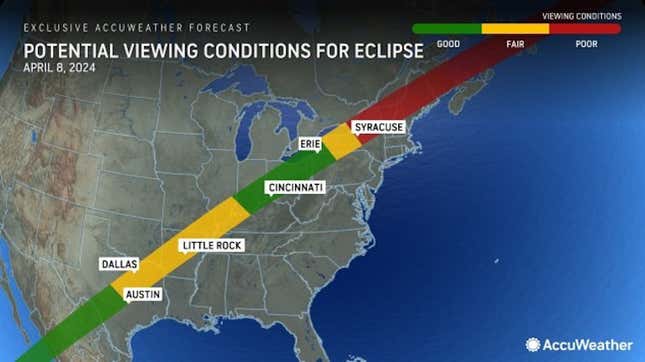The total solar eclipse is coming, that much is a certainty, as is its well-defined path of totality across North America. What’s considerably less clear, however, is how clear the skies will be on the big day, as varying weather forecasts suggest the possibility of cloud cover that would hinder visibility in different regions.
With the Great North American Total Solar Eclipse happening April 8, regions stretching from Mexico and Texas all the way to Maine in the U.S. and the Ontario, Quebec, and the Maritime provinces in Canada are gearing up for a rare astronomical spectacle. It’s obviously still really early, and things could change given the chaotic nature of weather, but long-range forecasters are weighing in, given weather patterns and emerging meteorological trends.
Related article: Your Definitive Guide to the 2024 Great North American Solar Eclipse
As this eclipse approaches, AccuWeather has released its initial forecast, 31 days ahead of the April 8 event. The eclipse’s path, considered incredibly fortunate due to its stretch across a large portion of the continent, places millions in a prime viewing position. However, weather conditions remain a critical factor for those hoping to see the eclipse (safely, of course).

According to AccuWeather senior meteorologist Paul Pastelok, southern Texas, along with areas of the Ohio Valley and Great Lakes, are currently favored for clear weather. Unfortunately, cloud cover is slightly more probable in the Mississippi and Tennessee Valleys, with the northeast facing the highest risk of cloudy conditions. Despite this, Pastelok notes the possibility of clear skies even in these riskier regions.
The challenge for meteorologists lies in accurately predicting cloud conditions for the brief period of totality, which lasts approximately four minutes. “There is a good possibility that a cold front will be moving across central and eastern U.S. near this time of the eclipse,” Pastelok said, and this could significantly influence cloud coverage. Moreover, a slow-moving storm system over the Southeast in April could extend cloud duration, hindering eclipse visibility.
A key factor in AccuWeather’s forecast is the gradual weakening of El Niño, known for altering North American weather patterns through warmer water temperatures in the eastern Pacific Ocean. Despite its weakening, El Niño’s residual effects could still drive active weather patterns during the eclipse, according to AccuWeather.
Complicating the forecast is the potential for severe weather to begin in early April, bringing a chance of (as of yet) unpredictable thunderstorms in the Plains, Mississippi Valley, and Tennessee Valley. Additionally, while the forecast suggests generally mild temperatures, reducing the likelihood of late-season cold, some chill may persist in the south-central Plains, Midwest, mid-Atlantic, and Northeast, AccuWeather says. This milder climate would make outdoor viewing more comfortable, while folks along the northern regions may still need to bundle up for the early spring conditions.
Again, this is just an early forecast. As each day and week passes from now to the eclipse, we should get an increasingly clearer picture of the conditions for that day. Hoping for clear skies in your area!

